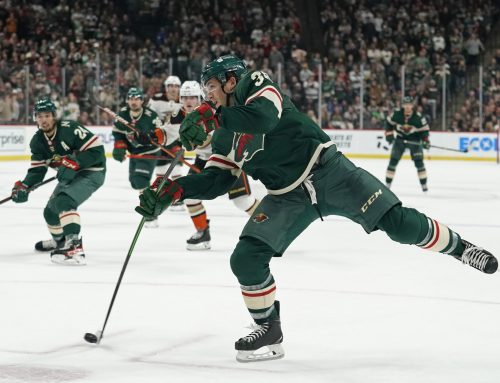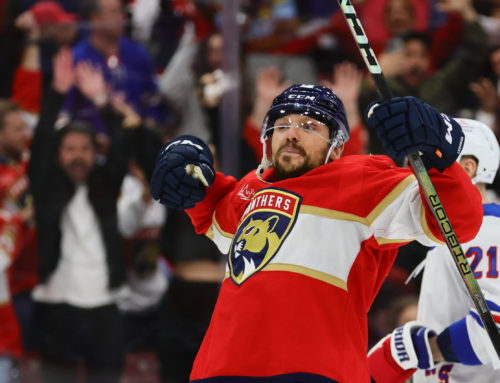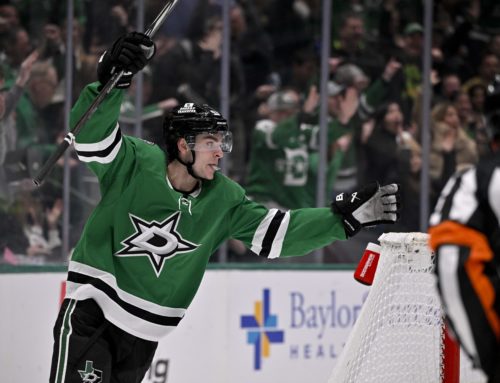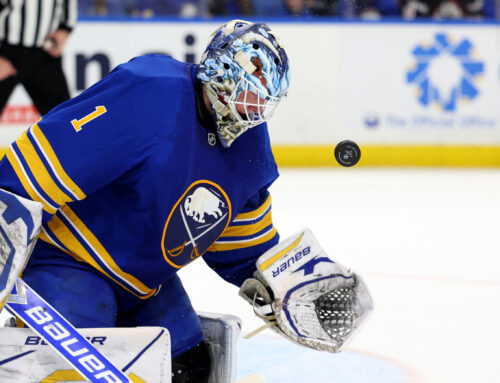
A look at the drafts stocks and Devan Dubnyk and Jake Allen, Nathan MacKinnon and Mark Scheifele inked long term, Jonathan Bernier exits The 6 and how will the top offenses of last year fare next season?
Devan Dubnyk
There should be profit potential with Dubnyk entering the 2016-17 campaign. The Wild will likely be underappreciated across the board, and Dubnyk's showing last year will probably be cast as a letdown.
However, since joining Minnesota, Dubnyk owns a .925 save percentage and a 2.13 goals-against average with a 59-35-8 record and 10 shutouts. Those numbers aren't completely topped up by his Veznia-calibre run in 2014-15, either.
Immediately following the coaching change in mid-February, Dubnyk posted a 14-3-1 stretch with a .928 save percentage, a shutout and just 37 goals allowed over 19 appearances. And even before the bench swap, Dubnyk had an above-average .917 Sv%.
Minnesota is deep with excellent two-way players throughout the lineup, and now they'll be coached by Bruce Boudreau. Dubnyk is a fringe No. 1 fantasy goalie with the upside to flirt with top-five billing at the position, again.
However, it seems likely he'll be sitting there waiting to be plucked well into the early middle rounds of drafts as a potential No. 2 for your virtual club. Depending on how your drafts unfold and the strategies you employ, Dubnyk's a tender to hone in on as a No. 1 or No. 2 goalie.
Jake Allen
After missing time with a knee injury and lower-body injury last season, and never being tasked with carrying the load over an entire season, Allen shouldn't be minted a slam-dunk No. 1 fake goalie … yet.
It's easy to say he hasn't proven himself, and when you wait around for proof, you often miss out. But in this case, what exactly are we going to miss out on? That's not entirely known at this point, and when we're reaching on an unknown there is more of a risk.
Allen has shown flashes of being a high-end goalie both in the real and virtual game, and he's improved in each season in the league. However, St. Louis has a huge void now without David Backes, and how that impacts the team is completely up in the air.
The division is loaded with star-studded teams, and in most cases, each of those teams have improved thus far in the offseason. The exception is Chicago, and until they fall back, they can't be taken lightly.
Yet, with that in mind, Allen has posted a 22-10-1 record with a .918 save percentage and 2.31 goals-against average against the Central Division for his career.
This is a perfect example of where a goalie would be an exceptional No. 2 for your roster, but he's going to be drafted as a No. 1, likely. The potential and concerns are both part of the package in this case.
Mark Scheifele
With an eight-year, $49 million contract ($6.125 million annual salary cap hit), Scheifele is now officially the No. 1 center in Winnipeg.
I've already shared my case for the emerging star, but the long-term commitment is beyond encouraging for Scheifele fully taking over as the top offensive pivot for the Jets.
And to reiterate from the above link, after the first couple/few rounds of drafts, why not swing for the fences with Scheifele in the hopes of hitting his true breakout?
Nathan MacKinnon
Similarly to Scheifele, MacKinnon is a player I've touched on already. And MacKinnon's tenure with Colorado was also extended Friday with a seven-year, $44.1 million contract ($6.3 million annual salary cap hit).
There is all kinds of upside here, obviously, and the asking price isn't too rich right now. A realistic set of benchmarks is the 30-goal, 30-assist 225-shot showing return that only nine players were able to accomplish last season.
Also, just like Scheifele, MacKinnon is a prime target in the early middle rounds to compliment a first round star. It's all going to fall in line soon for MacKinnon, and he's currently priced at his fantasy floor and well below his ceiling.
Jonathan Bernier
Mike put the follow-up, Anaheim-Toronto trade in context well yesterday.
One thing he didn't discuss was how this is a fantasy positive for Bernier. As indicated, Bernier will likely have a decent share of the starts for the Ducks, and 25 starts for Anaheim sure beats any number of starts he was going to have for Toronto.
In keeper/dynasty setups, this move also helps, as a solid season for Anaheim could have Bernier back on the radar to be a potential No. 1 goalie or work his way into an even greater timeshare for the 2017-18 season. Remember, he'll enter unrestricted free agency next July 1.
He currently has 194 career starts with a .915 save percentage, and he had a .923 save percentage in 2013-14 for Toronto — not bad. A change of scene will be fully welcomed, and Bernier becoming a viable No. 2 fantasy goalie in the future isn't out of the question. Perhaps, even as early as next season.
It could prove to be a mistake to label Bernier based on his performance the past two seasons considering Toronto was basement-dwelling club.
How do the top-2015-16 Offenses look?

The Ranking is the team's goals for, power-play percentage and shots on goal per game ranks added together. The lower the ranking the better the offense, and the above five teams finished with the lowest rankings.
Here are some quick-hit thoughts.
Dallas
The only major contributors missing are defensemen Alex Goligoski and Jason Demers, and their absences aren't of particular fantasy concern. Offensive growth from Valeri Nichushkin, Radek Faksa, Brett Richie and Stephen Johns should admirably compensate.
However, personnel might not be the only determinant to maintaining the offensive production for Dallas. A heightened focus on limiting the opposition could weaken the Dallas punch.
It's only a mild concern, and the Stars project to be in the running for the league's highest-scoring team again next year given their elite offensive weapons.
Washington
There was limited offseason movement, and with further development from Evgeny Kuznetsov, Andre Burakovsky, Dmitry Orlov and Jakub Varana, there is potential Washington is even more potent next year.
Lars Eller could offer more scoring punch than Jason Chimera, at least potentially, and there is no reason to anticipate Alex Ovechkin, Niklas Backstrom and John Carlson to do nothing but more of the same.
Boston
During their years as a perennial contender, the Bruins won with a stout defense. They were a legit offensive powerhouse in 2015-16 and missed the playoffs.
Go figure.
On the surface it is a scoring blow to replace David Backes with Loui Eriksson, but putting Ryan Spooner in a more specialized offensive role should limit the loss of Eriksson. Plus, Backes could prove to be a better power-play fit.
There is also significant upside for David Pastrnak to take a big step forward in his third season. And Boston is also very firmly in the running to add Jimmy Vesey, which would add another top-six scorer to the fold.
Overall, it would be surprising to see Boston remain among the top offensive teams in the league, but the Bruins don't project to fall below the middle of the pack, either.
Chicago
If you didn't know, the Blackhawks are extremely top heavy with high-end stars matched with supporting pieces. They had the second-highest shooting percentage on the power-play and the 27th-best shooting percentage at even strength.
It's another go figure.
Replacing the secondary production of Andrew Shaw and Teuvo Teravainen isn't going to be easy looking at the current Chicago depth chart. Yet, Brian Campbell's addition will be a positive both at even strength and with the man advantage.
From afar, in July, it would seem pretty difficult for Chicago to post another poor offensive season at five-on-five. However, on the contrary, the power-play efficiency doesn't seem too out of whack given their clientele. So, there is a case to suggest there won't be a significant drop in scoring.
Yet the lack of scoring depth is a concern, and a deep attack is something each of the final-four teams this spring boasted. Negative regression for Patrick Kane and Artemi Panarin almost seems like a given, too.
San Jose
The Sharks lost no one of significance and brought in a capable offensive support piece in Mikkel Boedker. While Patrick Marleau appears to be declining as an offensive contributor after posting just 22 even-strength points, Logan Couture and Joonas Donskoi are in their primes, and Tomas Hertl is poised to take a step forward.
No Roman Polak stands to help a youngster (Dylan DeMelo or Mirco Mueller) take a jump and help the team offensively, too. Additionally, there is no reason to expect the power play to slow down given the inherent and exceptional skill and chemistry.
Don't discount another big offensive season across the board for the fantasy relevant Sharks, and as a team, they should be explosive again in 2016-17.
***
Thanks, Dobberheads. Enjoy the weekend.
9 Comments
Leave A Comment
You must be logged in to post a comment.





 EDM
EDM FLA
FLA CHI
CHI ANA
ANA CGY
CGY CBJ
CBJ

Are you guys starting to run pools that award bonus points for even stregth production? My pools do just the opposite. They award bonus points for PPG’s, SHG’s & OTG’s. Games are played for the full duration. I just don’t get or understand why people keep referencing es production. What value does it serve?
My leagues are just plain points, doesn’t matter how. Though one league gives a TINY bit extra for PPPts.
For me, seeing how they perform at even strength if it’s a younger player is an indicator as to how soon or if ever they will get PP time.
Also, the ES production hints at whether a player will move up or down the depth chart (coach happy?). Terrible ES production could mean banishment to the fourth line or press box, whereas great ES production would mean staying on that productive line or perhaps a promotion and/or more PP time. Just an early indicator/tip-off as to things to come. For me, anyway.
To me, ES numbers are important. And if a PP vs. ES is too unbalanced towards PP, then that troubles me due to possible lack of sustainability.
I guess my brain just processes the data in a different way. I already have a pretty good idea of who’s going to get what ice time right out of the get go. Depth charts, line up combinations what ever you want to call them paint a very good base line. It shows next seasons opportunities for younger players to take on a greater role. A players stage of devopment, skill set, pedigree, etc all factor in.
I monitor TOI/GP & PP TOI/GP on a game by game basis. You pick up changes quickly staying on top of icetime daily. You can also find players who are seeing significant quantity & quality but not producing for odd reasons. I stole Leddy in 2 pools before he balanced out his points to opportunity. Paid a 3rd in 1, 20 team league, 24 man rosters, protect 12 & a 5th in the other same format but 9 keeper league. His addition won me a Cup.
Spalling & Winnik have historicly been solid even stregth producers. They will never play on my team.
I get yor meaning but i think for the layman, less informed following pp time would pay a faster dividend.
Dobber basically hit the main points, but also, the simplest explanation for keeping tabs on even-strength production is players spend the majority of their ice time at even strength. The Patrick Marleau example above is a prime example of why it helps. He scored more PP points than ES points, and to me that’s a huge concern.
I don’t have any concerns with players like Marleau, Brouwer etc. There are tons of players in the league that generate a significant portion of their offense on the PP 1/2 or more.
The clock is ticking for a player like Marleau but that #1 PP may stay in tact for all of next season or until Marleau is traded or signs else where.
As we have discussed before Marleau was the 13th best LW in my fantasy leagues last seasoi don’t see him declining significantly if at all. Depends on his role. Having played a ton of 3rd line C #2 when Couture was injured. I like him way better as Coutures LWer
Scary thing about Marleau is the simple, basic stat that sometimes we overlook: 70, 57 and 48.
When a 37-year-old is coming off three years that look like that, it’s hard to see something nice ahead.
In both of my keepers that count positions, we don’t differentiate which wing. Just ‘wingers’. Marleau ranked 59th last year among wingers in that system.
Trending in the wrong direction.
In our fantasy leagues, 8 of which I manage, 3 of which I participate in, all are 20 team leagues, 24 man rosters, we dress 3 C’s, 3 LW’s, 3 RW’s, 4 D & a goalie positions determined by CBS; via Elias,m all but 1 allow for a w year positional grace period.
Even with out differentiating positions for wingers Marleau at 59 would still be a decent #3 winger. In our format he’s a soft #1 at 13. Should he come out as a C in all but 1 he would be dropped. I may drop him in 1 & retain JT Miller. Will have to take a short term hit but I have Miller to be a 30 goal 70 point winger by the end of the 2017-18 season. The fact I also have Jokinen at LW in that pool really means I need to develop some youth. I will protect 3 LW’s Hoffman is my other but can’t bring myself to keep both Marleau & Jokinen. I need to trade out of that issue but the premium in our leagues works, RW, LW then D. Feeling out 3 solid starting wingers for these leagues is virtually impossible.
We protect 12 in all but 1 where we protect 9. 2 C, 2 LW, 2 RW, 2 D & a G in the 9 keeper league. The 12 keeper leagues allow for 3 wild cards. Players of your choosing. 2 of these leagues have been running for over 20 years, 1 over 25. Very astute managers. In the 12 keeper leagues you try to protect 3 LW’s & RW’s if at all possible as it’s a grave yard come the re draft.
Funny we talk about how hard C is to fill in the real world but inmy fantasy leagues easiect position to fill in a walk. You can buy a 50 point real life C in a walk, a 35 point RW will get you that & a pick or prospect. We can carry up to 9 prospects. At 45 games of NHL regular season experience they must be activated.
C is the easiest position to fill, I’ve always maintained that and I usually see writers say the same thing, no?
Marleau at 59 this year, is probably going to be Marleau at 65 or 70th next year? Too risky when there are lots of young up-and comers who rank around 59th who could be on the upswing
In our Keep 12, I won’t be keeping him – but I think he’d still get drafted by the fourth round so yeah, still some value
In a dynasty league what young goalie (less than 100 GP) would you rather have after the movement of this offseason – Jones, Gibson, Allen, or someone else?